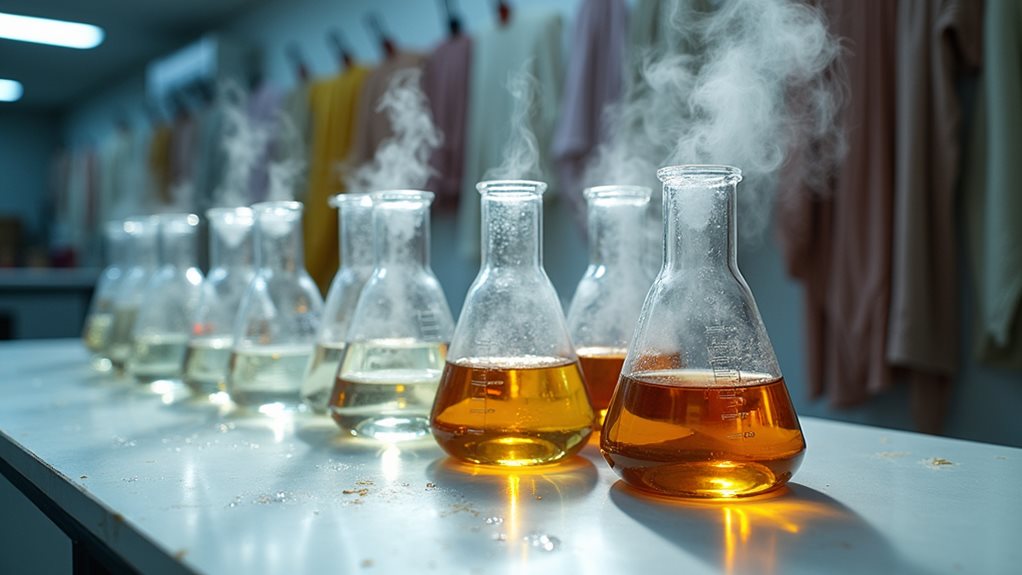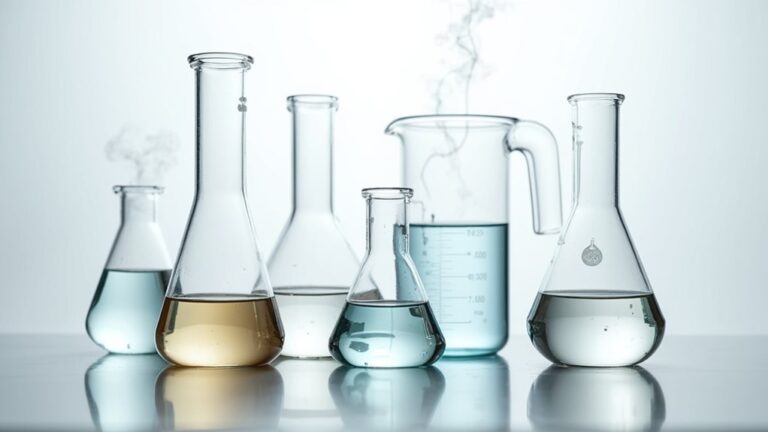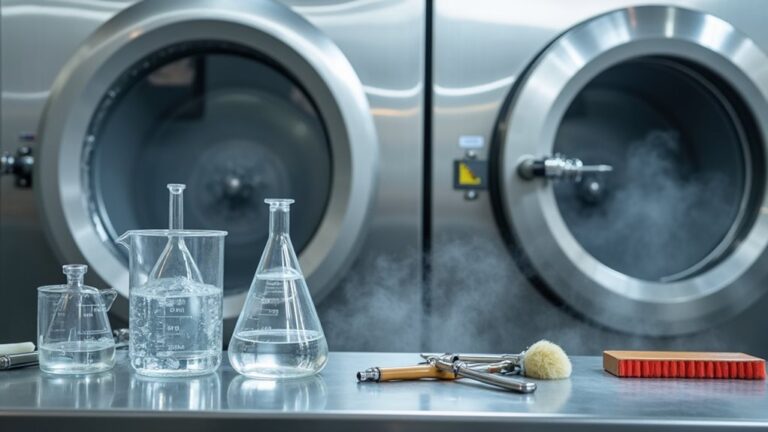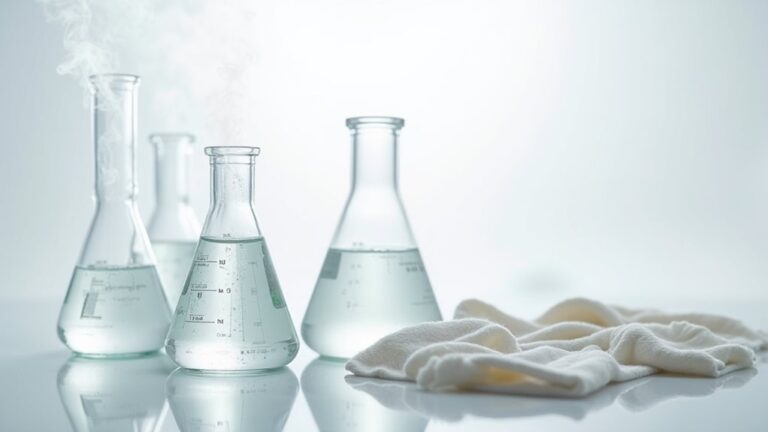Yes, traditional dry cleaning chemicals are toxic – perchloroethylene (PCE), the most common solvent, is classified as a carcinogen that can cause headaches, dizziness, and serious health issues with prolonged exposure. These chemicals don’t just disappear after cleaning; they remain on your clothes, with wool fabrics retaining up to 50% of PCE concentration even after a week. Fortunately, safer alternatives like CO2 cleaning and professional wet cleaning are becoming more available as regulations tighten and the industry evolves toward healthier practices.
What Chemicals Are Used in Traditional Dry Cleaning
When I first started paying attention to what actually happens to my clothes at the dry cleaner, I’ll admit I was pretty naive about the whole process – I mean, who really thinks about the chemistry behind getting that wine stain out of your favorite blazer?
Turns out, most traditional dry cleaning relies heavily on perchloroethylene (PCE), a powerful solvent that’s unfortunately classified as a carcinogen. While it’s incredibly effective at removing stubborn stains, these toxic chemicals come with serious health risks that honestly made me rethink my cleaning habits.
Some facilities are switching to alternative solvents or wet cleaning methods, but many still use PCE despite its environmental impact – something worth considering next time you’re dropping off that delicate silk dress.
The biggest concern is that PERC residues can linger on your freshly cleaned garments, especially when items haven’t been given enough time to properly air out before you pick them up.
Health Risks of Perchloroethylene (PCE) Exposure
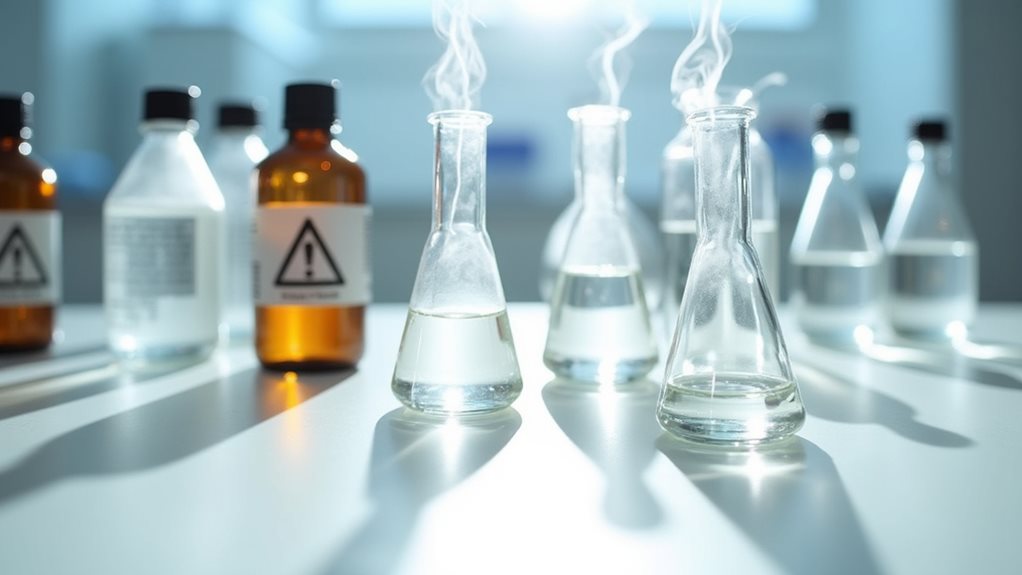
Although I used to joke that my dry cleaner’s chemical smell was just the “scent of cleanliness,” discovering that perchloroethylene is actually a known human carcinogen completely changed my perspective on those routine clothing drop-offs.
The U.S. National Toxicology Program has linked perchloroethylene (PCE) to major health risks, including bladder cancer and non-Hodgkin lymphoma, particularly among dry cleaning workers who face daily toxic exposure in poorly ventilated environments.
Even brief exposure can trigger headaches, dizziness, and respiratory issues, while chronic exposure damages your liver, kidneys, and central nervous system.
Even minimal contact with these toxic chemicals can cause immediate symptoms like headaches and dizziness, plus serious long-term organ damage.
What’s particularly concerning is that Georgetown University research found considerable PCE residue remaining on fabrics after cleaning, creating ongoing environmental exposure when these chemicals vaporize in your home 😰.
Fortunately, many dry cleaning facilities are now adopting safer alternatives like wet cleaning, liquid CO2, and hydrocarbon solvents to reduce these health risks.
How Toxic Residues Remain on Your Clothing

Despite what dry cleaners might tell you about their thorough cleaning process, those freshly pressed garments hanging in your closet are fundamentally chemical sponges that continue releasing toxic vapors long after you bring them home.
Here’s the uncomfortable truth: perchloroethylene (PCE) doesn’t magically disappear once your dry cleaned clothes are “clean.”
Georgetown University researchers discovered that repeated cleaning cycles actually increase PCE concentration on fabrics—wool, cotton, and polyester all retain considerable residual chemicals.
These toxic compounds vaporize from your garments, raising indoor air levels and creating ongoing toxic exposure.
Even after a week, wool fabrics still contained 50% of their original PCE concentration.
Your heightened risk continues every time you wear these garments, as the health effects compound with each exposure.
The EPA has classified PERC as a probable human carcinogen, linking it to neurological problems, liver damage, and reproductive issues.
Environmental Impact of Dry Cleaning Solvents
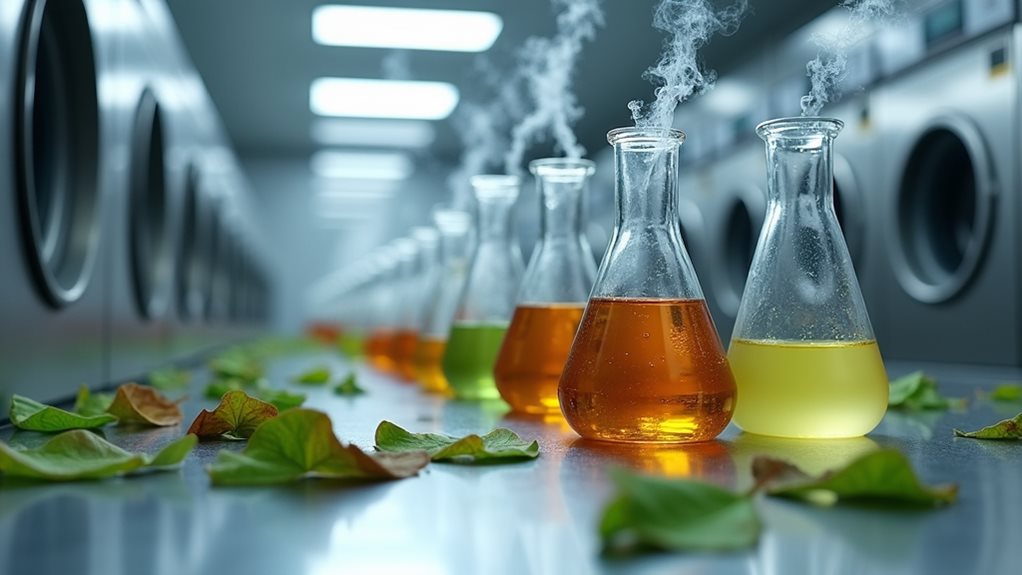
While your clothes might look spotless after dry cleaning, the environmental aftermath tells a dramatically different story that extends far beyond your closet.
When you drop off that favorite blazer, you’re unknowingly contributing to a cycle where PCE and other dry cleaning solvents create lasting contamination that affects our shared environment in ways most people never consider.
The environmental impact reaches every corner of our ecosystem:
The cascading effects of dry cleaning chemicals ripple through air, water, and soil with devastating consequences for our planet.
- Air quality deterioration – PCE escapes ventilation systems, lingering in outdoor air for weeks 🌬️
- Soil and water contamination – Improper disposal creates ground pollution affecting local ecosystems
- Marine life endangerment – Toxic chemicals seep into water systems, harming aquatic creatures
- Ozone layer depletion – Chemical reactions contribute to atmospheric damage
- Human health risks – Contaminated water supplies threaten community wellbeing
Fortunately, many modern dry cleaners are transitioning to eco-friendly alternatives like wet cleaning, liquid CO2 cleaning, and hydrocarbon-based solvents that significantly reduce environmental harm.
Understanding these consequences helps you make informed choices.
Cancer Risks for Workers and Consumers

Beyond the widespread environmental damage that touches every living creature on our planet, there’s an even more personal threat lurking in those crisp, chemically-cleaned garments hanging in your closet.
Workers in the dry cleaning industry face the highest cancer risk from perchloroethylene (PCE) exposure, with studies linking this toxic substance to multiple myeloma and non-Hodgkin lymphoma.
But here’s what might surprise you – consumers aren’t completely safe either. Every time you slip on that freshly dry-cleaned blazer, you’re potentially breathing in PCE vapors that remain trapped in the fabric.
Georgetown University researchers found notable residual chemicals on wool and cotton, with concentrations actually increasing after multiple cleanings.
Studies have also suggested potential links to bladder cancer, esophageal, and kidney cancers, though definitive proof in humans remains limited.
Your health matters, and understanding this exposure helps you make informed decisions about professional cleaning services.
Safer Alternative Cleaning Methods Available

You don’t have to resign yourself to toxic chemicals when caring for your favorite garments, because innovative cleaning methods like carbon dioxide cleaning and professional wet cleaning are revolutionizing the industry with impressive results.
I remember feeling skeptical when my local cleaner first mentioned these alternatives – honestly, cleaning clothes with CO2 sounded like something from a sci-fi movie! 😅
These safer methods effectively remove stains and odors without exposing you to harmful solvents, proving that protecting your health doesn’t mean compromising on quality.
Other eco-friendly alternatives include hydrocarbon-based cleaners and liquid silicone, which provide the same effective stain removal as traditional solvents while reducing environmental and health risks.
Carbon Dioxide Cleaning
As someone who’s spent years worrying about what chemicals might be lurking in my freshly cleaned blazers, I can’t tell you how relieved I felt when I discovered carbon dioxide cleaning—a game-changing alternative that uses pressurized CO2 instead of those harsh, potentially toxic solvents we’ve been discussing.
This liquid CO2 cleaning method isn’t just environmentally friendly; it’s genuinely safer for you and delivers impressive cleaning results without the health risks associated with traditional dry cleaning.
Here’s what makes carbon dioxide cleaning so remarkable:
- Uses pressurized CO2 as a solvent, eliminating harmful chemicals entirely
- Produces zero hazardous waste and allows CO2 reuse
- Non-flammable and non-toxic, leaving no chemical residues on your clothes
- Achieves superior cleaning while being gentler on delicate fabrics
- Offers truly safe garment care solutions for health-conscious consumers
Unlike perchloroethylene, which has been classified as a potential carcinogen, liquid carbon dioxide cleaning provides an effective alternative that maintains excellent stain removal capabilities while completely eliminating toxic exposure risks.
Professional Wet Cleaning
When I first heard about professional wet cleaning, I’ll admit I was skeptical—after all, wouldn’t water ruin my wool suits and silk blouses the same way it does when I accidentally toss them in my home washer? 😅
However, this isn’t your typical laundry process; professional wet cleaning uses specialized equipment that precisely controls moisture levels, temperature, and agitation to safely clean even the most delicate fabrics that you’d normally take to a traditional dry cleaner.
What really impressed me was learning that this method eliminates hazardous chemicals like perchloroethylene while using biodegradable detergents instead, which means you’re not walking around with chemical residues on your clothes.
Many cleaners are embracing these eco-friendly practices, proving that environmental safety doesn’t require sacrificing quality cleaning results.
For those looking for additional eco-friendly options, steam cleaning provides another chemical-free alternative that uses high-temperature water vapor to effectively remove dirt and odors from garments.
Regulatory Actions and Industry Changes
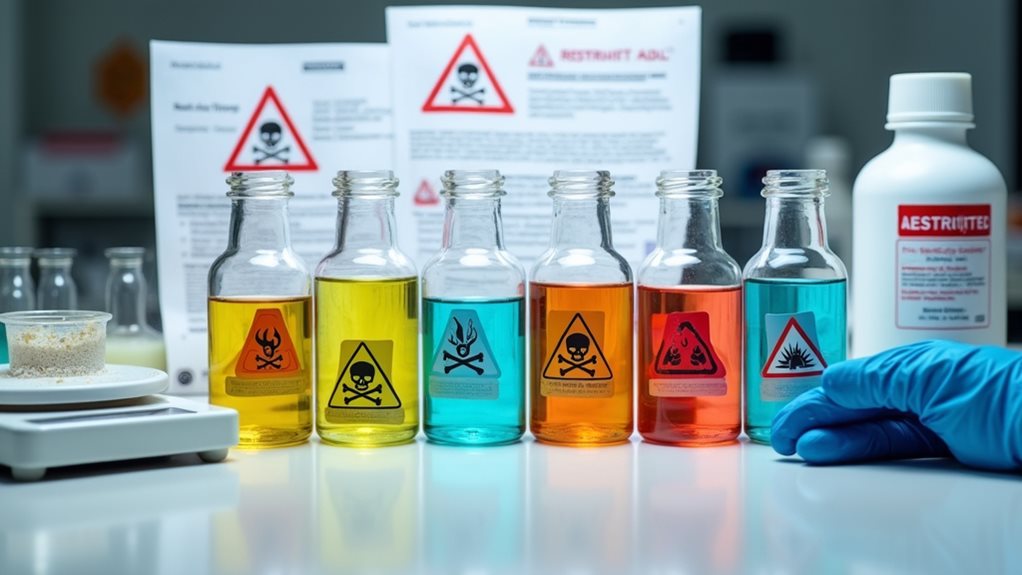
Federal intervention has finally arrived to tackle the toxic dry cleaning crisis, though frankly, it’s taken far too long for regulators to catch up with what scientists have known for decades.
The Environmental Protection Agency (EPA) has issued extensive bans on trichloroethylene (TCE) and perchloroethylene (PCE), two notorious dry cleaning chemicals that’ve been poisoning workers and communities for years.
You’ll see these regulatory actions reshape the entire industry, forcing a long-overdue shift toward green dry cleaning alternatives.
Here’s what these health risks-focused changes mean for you:
- TCE will be phased out within one year across most applications
- PCE must be eliminated within three years from many uses
- Workplace exposure to toxic cleaners will drop by 97%
- Industry pushback continues despite safer alternatives existing
- Green dry cleaning options will become standard practice
These regulatory changes also address the persistent environmental contamination caused by improper disposal practices, which have led to groundwater contamination and soil pollution that can persist for decades in affected areas.
How to Choose Non-Toxic Dry Cleaning Services
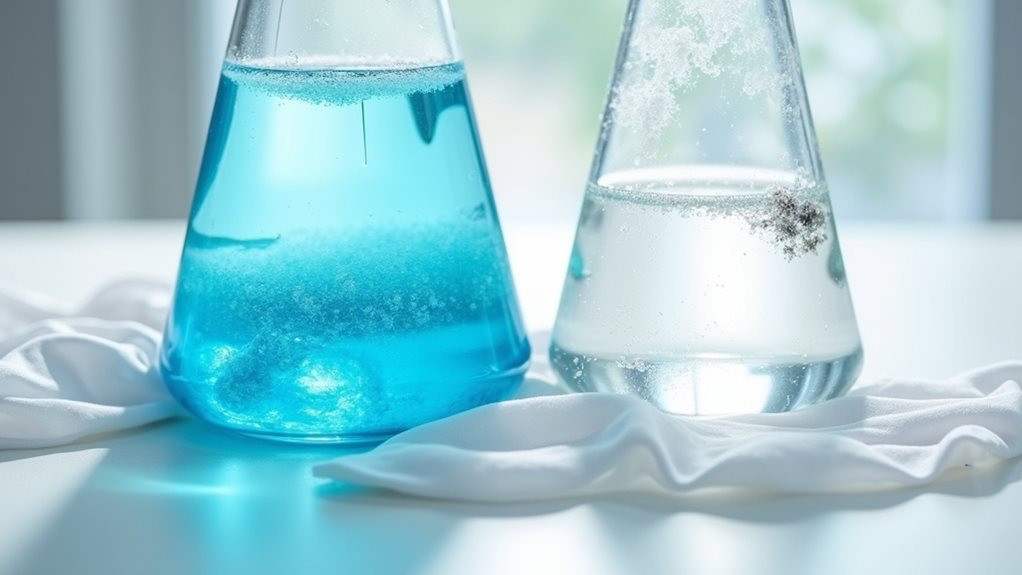
Why should finding a safe dry cleaner feel like searching for a needle in a haystack when your health’s on the line?
Start by asking your dry cleaning services about their solvents – if they’re still using perchloroethylene or other toxic chemicals, keep looking. I learned this the hard way after years of headaches from freshly cleaned suits!
Search for cleaners offering eco-friendly methods like liquid carbon dioxide or professional wet cleaning, which use non-toxic solvents that won’t compromise your family’s wellbeing.
Look for certifications showing environmentally responsible practices – these businesses actually care about health risks, rather than solely profits.
Modern dry cleaning facilities are heavily regulated and equipped with advanced safety protocols that significantly reduce exposure risks compared to older operations.
Once you’ve found the right cleaner, always air out dry cleaned clothes outdoors before bringing them inside. Your lungs will thank you!

